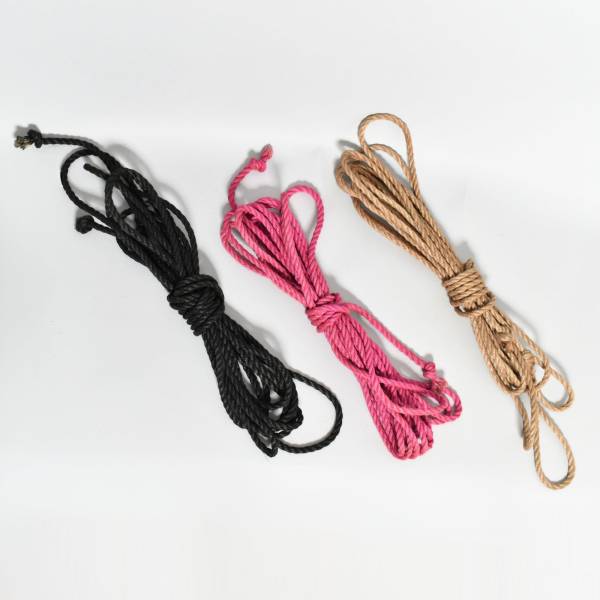Shibari & Bondage
Shibari: The art of tying your partner up with sensuality.
Let your senses vibrate with an introduction to shibari.
Shibari & Bondage
- SAC CONTRAINTE INTÉGRAL99,00 €
- MINI BONDAGE TAPE NOIR 17.5M7,00 €
- Ogawa Jute Rope Color
Explore the art of shibari with Ogawa jute rope, ideal for precise binding.Made from natural fibers, it combines sturdiness and authenticity. Its rough texture ensures a perfect grip, ideal for amateurs and experts alike. Enhance your BDSM sessions with this must-have accessory.
27,00 € - Bondage Tape Red 15m
Tie your submissive's hands or ankles firmly during BDSM sessions. A real must-have accessory, restraint tapes won't stick to skin or hair. PVC material, phthalate-free.
9,90 € - BONDAGE TAPE TRANSPARENTE 20M15,00 €
A little history
Shibari, or kinbaku, is the name given to Japanese bondage. In the 17th century, Japanese criminals and prisoners were captured and tortured with ropes. They were tied differently depending on the crime they had committed, their ages and social status. Most of the punishments inflicted led to death. Shibari is the legacy of these torture techniques. Fortunately, it no longer serves the same purpose today. The strong sensual potential of rope restraint has brought shibari into the category of erotic games. It is now practiced all over the world, whether it is in the context of BDSM or not. Shibari can be practiced on the floor, in semi-suspension or in suspension.
An art in its own right
In the collective imagination, shibari is associated with sex and the world of S&M. In reality, it has a very strong spiritual dimension, in addition to its artistic aspect. The knots form complex geometrical figures that sublimate the body. The patterns are carefully thought out and each has its own meaning. The aesthetic side of this bondage has attracted many photographers. By working hand in hand with shibari artists, they have contributed to export this art in the West.
Shibari and BDSM
Many partners say they feel a deep connection when they practice shibari. During a session, a permanent dialogue is established between thebinder and the binded. The one who ties is listening to his or her model, to his or her breathing and movements. Japanese bondage lends itself particularly well to games of submission and domination. It must be done slowly to produce its full effect. It aims to constrain, but should not cause pain. The game is to endure this constraint and not to suffer.
Shibari does not necessarily involve sex in the strict sense of the word. The image of a submissive, bound person is very powerful and it already brings strong erotic feelings. The person who is tied up lets go completely, abandons himself to the other in a pleasurable way. Paradoxically, she is constrained by bonds, but her mind is free to feel all the pleasure that her master offers her.
If however, you wish to live a more BDSM experience, you can enrich the practice of shibari with SM accessories like a gag or a blindfold. In order to titillate your submissive, opt for breast clamps. For fetishists, it is possible to wear a latex suit or other vinyl accessories. The dominant may also caress, kiss, bite or penetrate his or her submissive during bondage.
Can everyone get tied up?
Even if we tend to see more women tied up, bondage is also for men. The technique is the same, the knots don't change and men can take as much pleasure as women with shibari. In the same way, one could believe that this practice is reserved for slender people. Books or photos show more slim models. This is of course a misconception. No matter what body you have, you can practice shibari and enjoy it. However, it would not be safe to engage in bondage if you have a heart condition or blood circulation problem.
What parts of the body can be restrained with shibari?
Some patterns focus on specific parts of the body, such as the hands and arms, legs, genitals or chest. The binding may start from these anchor points and then spread to the entire body. It can then lead to a total immobilization, as in the famous hog-tie position.
How to learn shibari?
In order to practice shibari safely, it is necessary to initiate yourself to this practice. Clubs exist all over the world. As a simple curious person, you can ask to be tied up by a professional. If you like it and if you want to go further in the discovery of shibari, then you can sign up for courses or workshops. The sessions are generally collective even if you can book private lessons. The principle is simple: you come to the classes, sometimes with your partner, and you discover the Japanese bondage, the basic knots as well as the safety gestures. Contrary to what one might think, shibari is not necessarily practiced naked. It is required to wear loose clothing, or close to the body, to avoid that the fabric does not hinder the progression of the rope.
Participating in these workshops will give you some experience and will help you acquire automatisms. When you have mastered the rope, there will be more room for your brain. You will be able to enjoy the moment better. If you are the one tying, you will discover how to put intention into your handling of the rope. Tying fast or slow, tightening or loosening your knots, letting the rope slide sensually over certain sensitive areas, etc. Once you have this basic knowledge, you will be able to purchase books specializing in bondage to learn new positions or patterns.
What is needed to practice shibari?
Japanese bondage is essentially based on the use of ropes. However, some positions can be performed with additional restraining elements. For example, bamboo (to stay in the Asian spirit of shibari ) or furniture, like a chair or a table. If you want to try suspension or semi-suspension, you will need other accessories, such as bondage rings or carabiners. Rings come in many sizes and can be made of wood or metal. Some are divided, they have a geometric pattern in the center. This allows you to organize your ropes better if there are many of them and to prevent them from getting tangled. There are also rotating rings, so that the person tying the rope can spin his or her partner around and admire him or her from every angle. Still for the suspension, you will need a suspension kit to be able to hoist your partner, a beam for example.
How to choose your ropes?
The ropes are generally between 7 and 8 m long, but you can find shorter ones. Their diameter can vary from 4 to 6 mm. The ropes used in traditional shibari have a larger diameter, between 8 and 10 mm. Beginners will find it easier to handle ropes of 3 or 4 meters. They will be able to practice maintaining a constant tension and doing partial bondage before moving on to more complicated patterns requiring longer ropes.
The other important criterion in choosing a rope is its material. Cotton ropes are for novices, but are reserved for floor work. They are not suitable for suspension or semi-suspension. Jute or hemp ropes allow a wider practice of shibari. Note however that hemp has a strong and rather special smell. Some people love it, because it creates a special atmosphere by stimulating the sense of smell, a sense sometimes left aside in SM games. Others, however, can't stand it. You'll only find out by experimenting. Hemp and jute make very strong but relatively soft ropes. You can find other materials, such as coconut fiber, but these ropes are reserved for experienced users, as they are very rough. They can cut the skin if not used properly and are more difficult for the person being tied.
The color of the rope is also important. You can of course vary according to the tone you want to give to the session. Raw, natural ropes will have a rather traditional character. Red and black will be ideal if you want to create a SM atmosphere. If you want a more original product, you can turn to pink, green or blue ropes, there is something for everyone. Anyway, a rope always reflects an intention. The one you choose will say a lot about the relationship you have with your partner and the atmosphere of the upcoming session.
Some tips for a safe practice
- When you start a shibari session, make sure you have safety scissors with you. This essential accessory allows the person tying to intervene quickly in the event of an anxiety attack, discomfort or excessive pain.
- Before the game begins, discuss your limits and choose a safe word. This is a common practice in the BDSM world. Saying this word immediately interrupts the session. Don't hesitate to use it, so you can discuss what is not working. Your complicity will only be strengthened.
- If the person being restrained also has a gag, he or she will not be able to say the safe word if there is a problem. Instead, they can hold a small object in their hand. Dropping it will mean that there is a problem and that the session should be stopped.
- Only allow yourself to be tied up by someone you trust. This person must respect the rules set at the beginning. You must also be able to dare to point out the slightest problem, the slightest discomfort, the slightest pain.
- Before starting, the submissive person must remove any piercings or earrings. They could interfere with the progress of the rope or even get caught in it, which is dangerous.
- The person who is preparing to be tied up should tell his or her partner if there are any areas that should not be tied up (a burn, a recent tattoo, irritated areas or areas prone to eczema, for example).
- Some people are more flexible than others. If you tie, you should never force your partner. You should respect the limits imposed by your body.
- Be careful not to compress joints or nerves. This could result in damage to the submissive.
- Before suspending your partner with suspension rings, remember to check the maximum weight they can support.
- Be careful, a suspended position will be more difficult to support for a long time than a position on the ground.
- As in any bondage, the person tied up should never be left alone.












